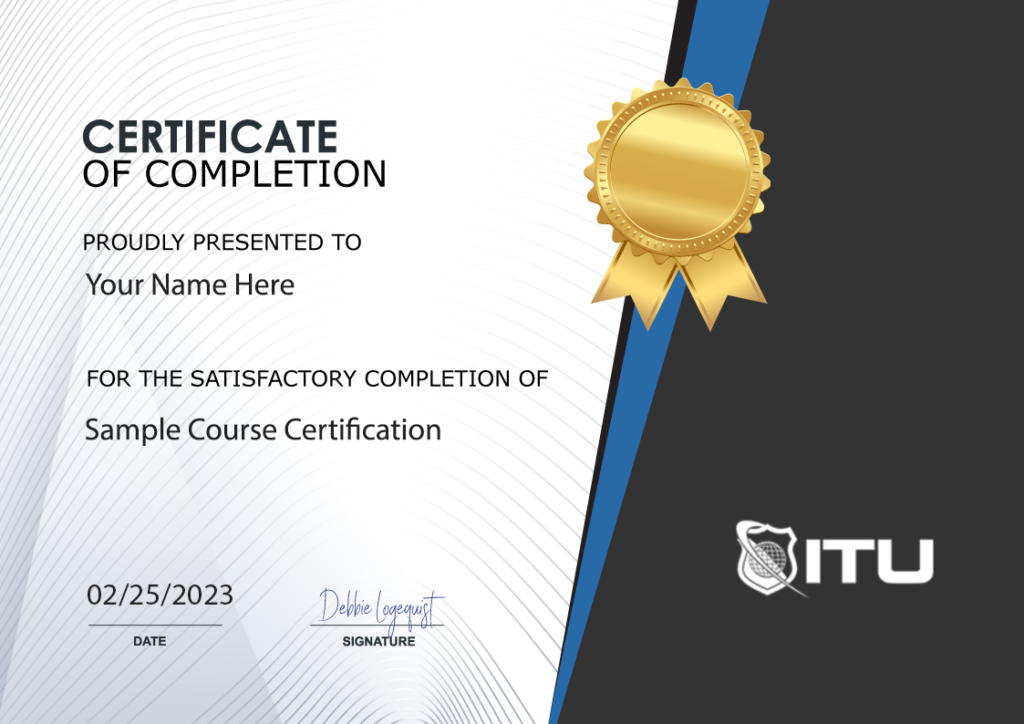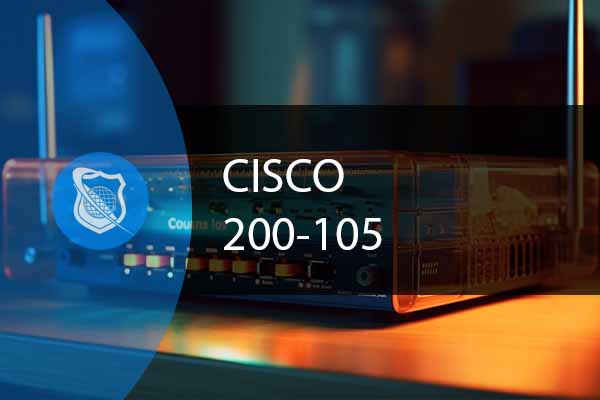Cisco 200-105 Interconnecting Cisco Networking Devices
After taking this Cisco 200-105 course, you will be able to understand and utilize network switching and routing concepts including the spanning tree protocol, VLAN trunking, dynamic routing protocols, and IPv4 and IPv6 troubleshooting.
Included In This Course



Closed Captions



Certificate of Completion
Course Description for Cisco 200-105 ICND2: Interconnecting Cisco Networking Devices Part 2
The Cisco 200-105 ICND2 course is designed to provide an in-depth understanding of the concepts and technologies required for configuring and troubleshooting Cisco networking devices. This course covers advanced networking topics, including LAN and WAN technologies, IPv4 and IPv6 routing, network security, and cloud-based networking. By completing this course, learners will gain practical skills and knowledge necessary to manage and optimize enterprise network infrastructures.
Throughout the course, you will delve into the intricacies of Ethernet LANs, explore the implementation of VLANs and Spanning Tree Protocol, and understand the configuration of OSPF and EIGRP routing protocols. Additionally, the course addresses the configuration and management of wide area networks (WANs), quality of service (QoS) mechanisms, and IPv6 implementation. Real-world applications and hands-on labs ensure that you can apply these concepts effectively in a professional setting.
What You Will Learn in Cisco 200-105 ICND2
By taking this course, you will gain comprehensive knowledge and hands-on experience in a wide range of Cisco networking topics. The skills acquired will enhance your ability to design, implement, and troubleshoot network systems efficiently. Key learning outcomes include:
- Understanding Ethernet LAN fundamentals and VLAN trunking
- Implementing and managing Spanning Tree Protocol
- Configuring and troubleshooting OSPF and EIGRP for IPv4 and IPv6
- Setting up and managing point-to-point WANs and private WANs with Ethernet, MPLS, and Internet VPNs
- Applying basic and advanced access control lists
- Implementing Quality of Service (QoS) in network environments
- Routing and troubleshooting IPv4 and IPv6 networks
- Overview and implementation of cloud-based networking solutions
Exam Objectives for Cisco 200-105 ICND2 Certification
This course prepares you for the Cisco 200-105 ICND2 certification exam, administered by Cisco. The exam objectives include:
- LAN Switching Technologies (20%)
- Routing Technologies (40%)
- WAN Technologies (10%)
- Infrastructure Services (20%)
- Infrastructure Maintenance (10%)
By mastering these objectives, you will be well-equipped to pass the certification exam and advance your career in networking.
Who This Cisco 200-105 ICND2 Course is For
This course is ideal for networking professionals who want to enhance their skills and knowledge in Cisco networking technologies. It is also suitable for individuals preparing for the Cisco 200-105 ICND2 certification exam. The course is beneficial for:
- Network administrators and engineers
- IT professionals seeking to expand their networking expertise
- Students and career changers aiming to enter the networking field
- Anyone interested in obtaining Cisco certification
Possible Jobs You Can Get With This Knowledge
Completing the Cisco 200-105 ICND2 course opens up various career opportunities in the networking field. With the skills gained, you can pursue roles such as:
- Network Engineer
- Network Administrator
- Systems Engineer
- IT Support Specialist
- Network Consultant
- Technical Support Engineer
The course equips you with the expertise needed to excel in these positions and advance your career in the IT industry.
Average Industry Salaries for People with These Skills
Professionals with Cisco networking skills are in high demand, and their expertise is rewarded with competitive salaries. Approximate salary ranges for roles in this field include:
- Network Engineer: $70,000 – $110,000 per year
- Network Administrator: $60,000 – $90,000 per year
- Systems Engineer: $75,000 – $115,000 per year
- IT Support Specialist: $50,000 – $80,000 per year
- Network Consultant: $80,000 – $120,000 per year
- Technical Support Engineer: $55,000 – $85,000 per year
These figures highlight the financial benefits of gaining expertise in Cisco networking technologies.
Get Started Today
Enroll in the Cisco 200-105 ICND2 course today and take the first step towards advancing your career in networking. With comprehensive content, practical labs, and expert instruction, this course provides everything you need to succeed. Don’t miss this opportunity to enhance your skills and achieve your professional goals. Sign up now and start your journey to becoming a Cisco certified networking professional!
Key Term Knowledge Base: Key Terms Related to Cisco 200-105 ICND2
Understanding key terms is essential for those preparing for the Cisco 200-105 ICND2 exam, as it provides a foundation for complex networking concepts and practices central to Cisco’s network devices.
| Term | Definition |
|---|---|
| ICND2 (Interconnecting Cisco Networking Devices Part 2) | A certification exam focusing on advanced networking concepts and Cisco-specific technology. |
| WAN (Wide Area Network) | A network that extends over a large geographic area, typically to connect multiple LANs. |
| IPv4/IPv6 | Internet Protocol versions 4 and 6, the underlying technologies for routing and addressing on the Internet. |
| VLAN (Virtual Local Area Network) | A network of computers that behave as if they are connected to the same wire even though they may be physically located on different segments of a LAN. |
| OSPF (Open Shortest Path First) | A routing protocol for IP networks that uses a link state routing algorithm. |
| EIGRP (Enhanced Interior Gateway Routing Protocol) | A Cisco proprietary routing protocol that uses a complex metric based on bandwidth, delay, load, and reliability. |
| Spanning Tree Protocol | A network protocol that ensures a loop-free topology for any bridged Ethernet local area network. |
| VLAN Trunking | The practice of sending multiple VLANs over a single network link. |
| Dynamic Routing | The ability for a router to forward data via a different route based on current conditions on the network. |
| Routing Protocols | Protocols that support the router in choosing the best path across a network. |
| Access Control Lists (ACLs) | Lists of permissions attached to an object specifying which users or system processes are granted access to objects. |
| Quality of Service (QoS) | The description or measurement of the overall performance of a service, particularly the performance seen by the users of the network. |
| HSRP (Hot Standby Router Protocol) | A Cisco proprietary redundancy protocol for establishing a fault-tolerant default gateway. |
| MPLS (Multiprotocol Label Switching) | A routing technique in telecommunications networks that directs data from one network node to the next based on short path labels. |
| VPN (Virtual Private Network) | A technology that creates a safe and encrypted connection over a less secure network, such as the internet. |
| Network Troubleshooting | The collective measures and processes used to identify, diagnose, and resolve operational issues within a network. |
| Network Switching | The process of directing a packet through a network to a specific destination. |
| Point-to-Point Connection | A direct link between two devices in a network. |
| IPv4 Routing | The process of routing internet traffic using IPv4 addresses. |
| IPv6 Routing | The process of routing internet traffic using IPv6 addresses. |
This knowledge base is crucial for anyone studying for the Cisco 200-105 ICND2 exam, as it covers the fundamental concepts and technologies relevant to modern network environments.
Frequently Asked Questions About Cisco 200-105: ICND2 – Interconnecting Cisco Networking Devices
What is the Cisco 200-105 ICND2 course?
The Cisco 200-105 ICND2 course is designed to provide an in-depth understanding of advanced networking concepts and technologies required for configuring and troubleshooting Cisco networking devices. It covers topics such as Ethernet LANs, VLANs, Spanning Tree Protocol, OSPF and EIGRP routing, WAN technologies, IPv6, QoS, and cloud-based networking.
Who should take the Cisco 200-105 ICND2 course?
This course is ideal for networking professionals, network administrators, IT professionals, students, career changers, and anyone preparing for the Cisco 200-105 ICND2 certification exam. It is designed for those who want to enhance their skills and knowledge in Cisco networking technologies.
What are the key learning outcomes of the Cisco 200-105 ICND2 course?
The key learning outcomes include understanding Ethernet LAN fundamentals, implementing VLANs and Spanning Tree Protocol, configuring OSPF and EIGRP for IPv4 and IPv6, managing WAN technologies, applying access control lists, implementing QoS, routing and troubleshooting IPv4 and IPv6 networks, and understanding cloud-based networking solutions.
What career opportunities are available after completing the Cisco 200-105 ICND2 course?
After completing this course, you can pursue roles such as Network Engineer, Network Administrator, Systems Engineer, IT Support Specialist, Network Consultant, and Technical Support Engineer. The skills gained from this course will help you excel in these positions and advance your career in the IT industry.
What is the average salary for professionals with Cisco networking skills?
Professionals with Cisco networking skills can expect competitive salaries. Approximate salary ranges include: Network Engineer ($70,000 – $110,000 per year), Network Administrator ($60,000 – $90,000 per year), Systems Engineer ($75,000 – $115,000 per year), IT Support Specialist ($50,000 – $80,000 per year), Network Consultant ($80,000 – $120,000 per year), and Technical Support Engineer ($55,000 – $85,000 per year).
Proudly DisplayYour Achievement
Upon completion of your training, you’ll receive a personalized certificate of completion to help validate to others your new skills.
Cisco 200-105 ICND2 Interconnecting Cisco Networking Devices Part 2 Course Content
Module 1: Configuring Ethernet LANs
- Introduction
- Ethernet LAN Fundamentals- Part 1
- Ethernet LAN Fundamentals- Part 2
- Implementing Virtual LANs- Part 1
- Implementing Virtual LANs- Part 2
- Using VLAN Trunking- Part 1
- Using VLAN Trunking- Part 2
- Understanding Spanning Tree Protocol- Part 1
- Understanding Spanning Tree Protocol- Part 2
- Understanding Spanning Tree Protocol- Part 3
- Spanning Tree Implementation- Part 1
- Spanning Tree Implementation- Part 2
- Spanning Tree Implementation- Part 3
- Security Management- Part 1
- Security Management- Part 2
- Security Management- Part 3
- Security Management- Part 4
Module 2: Configuring IPv4 Routing Protocols
- Understanding OSPF- Part 1
- Understanding OSPF- Part 2
- Understanding OSPF- Part 3
- Implementing OSPF- Part 1
- Implementing OSPF- Part 2
- Implementing OSPF- Part 3
- Implementing OSPF- Part 4
- Understanding EIGRP- Part 1
- Understanding EIGRP- Part 2
- Understanding EIGRP- Part 3
- Implementing EIGRP- Part 1
- Implementing EIGRP- Part 2
- Troubleshooting IPv4- Part 1
- Troubleshooting IPv4- Part 2
- Troubleshooting IPv4- Part 3
Module 3: Wide Area Networks
- Implementing Point-To-Point WANs- Part 1
- Implementing Point-To-Point WANs- Part 2
- Implementing Point-To-Point WANs- Part 3
- Private WANs With Ethernet And MPLS- Part 1
- Private WANs With Ethernet And MPLS- Part 2
- Private WANs With Ethernet And MPLS- Part 3
- Private WANs With Internet VPNs- Part 1
- Private WANs With Internet VPNs- Part 2
- Private WANs With Internet VPNs- Part 3
Module 4: IPv4 Services
- Basic Access Control Lists- Part 1
- Basic Access Control Lists- Part 2
- Advanced Access Control Lists- Part 1
- Advanced Access Control Lists- Part 2
- Quality Of Service- Part 1
- Quality Of Service- Part 2
Module 5: IPv4 Routing And Troubleshooting
- IPv4 Routing In The LAN- Part 1
- IPv4 Routing In The LAN- Part 2
- Implementing HSRP- Part 1
- Implementing HSRP- Part 2
- Troubleshooting IPv4 Routing- Part 1
- Troubleshooting IPv4 Routing- Part 2
Module 6: IPv6 Routing
- IPv6 Implementation And Routing Basics- Part 1
- IPv6 Implementation And Routing Basics- Part 2
- IPv6 Implementation And Routing Basics- Part 3
- IPv6 Implementation And Routing Basics- Part 4
- Implementing OSPF For IPv6- Part 1
- Implementing OSPF For IPv6- Part 2
- Implementing EIGRP For IPv6- Part 1
- Implementing EIGRP For IPv6- Part 2
- IPv6 Access Control Lists- Part 1
- IPv6 Access Control Lists- Part 2
Module 7: Cloud Based Networking
- Overview Of Cloud Computing- Part 1
- Overview Of Cloud Computing- Part 2
- Conclusion
| 5 star | 82 | 82% |
| 4 star | 17 | 17% |
| 3 star | 1 | 1% |
| 2 star | 0% | |
| 1 star | 0% |
Sorry, no reviews match your current selections
Your Training Instructor
Patrick is a skilled presenter with a strong background in IT training and certification covering general information technology, network administration, and consulting. His strong customer service background and skills both in support and presentation situations allow him to effectively communicate course information in an engaging manner. He specializes in areas such as Active Directory, Microsoft Exchange, Windows Network Infrastructure, and Security.

Subscribe To All-Access
Lock In $16.99 / Month Forever
Access this course and over 3,000 hours of focused IT training. Start your first month for only $1.00. Then lock in only $16.99 / month for life.
- Get Every Course
- Free Updates / New Content Added
- 3,000+ Hours of Training
- Price Lock Guarantee
- Games / Flashcards
- 21,000+ Practice Questions
$49.99 $16.99 Monthly
$49.00




good
Smooth delivery and easy access to LMS. Good to see that the LMS offers progress tracking. Would be great if badges were offered on completion of courses to share via Credly to future employers.